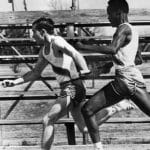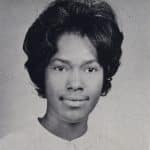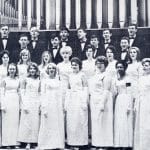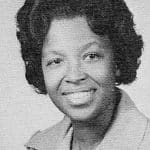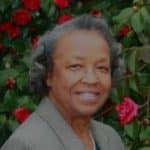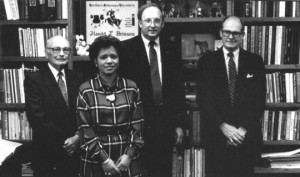
SAU Board of Trustees in 1990: l. to r.: Auburn Smith, Virginia Todd, Bob Burns, and Bill Handy (Click photo to enlarge)
(Excerpted from James F. Willis, Southern Arkansas University: The Mulerider School’s Centennial History, 1909-2009, pp. 237-239)
The gradual integration of the college was undoubtedly the most important of many challenges that SSC faced in an era of great change from 1962 to 1976. It was one of the most turbulent periods in American history and included civil rights protests, the Vietnam War, assassinations and riots, youth rebellions, the feminist movement, inflation, and Watergate. These events and movements shook the nation. In many ways, SSC was isolated from the tumult, but it too felt the impact.
After Congress passed the Civil Rights Act of 1964, SSC’s board of trustees concluded on May 29, “Nothing was to be gained by refusing admittance to qualified Negroes.” But trustees were fearful of potential reactions. They knew that John Norman Warnock, a prominent segregationist leader in the state, lived in Camden, only thirty miles from campus. The board directed the president, Dr. Imon Bruce, to “handle the admission of Negroes in a manner that would not attract public attention nor likely result in an unusually large group entering the college at the same time.”
A small number of black students entered SSC in the 1964 fall semester. All commuted, and none lived on campus. Yearbook photos and student memories have indicated there were approximately ten students. Among them were Charlotte and Virginia Marks, daughters of Magnolia’s Marks Funeral Home’s owner- director. Thirty years later, Virginia Marks Todd would serve on SAU’s board of trustees. SSC’s initial desegregation was handled so quietly and smoothly that faculty members said it was months before they knew the dorms finally housed black students in fall 1966. A small number of black athletes that spring integrated the men’s track and women’s basketball teams.
· · · · · · · ·
Raymond “Rip” Powell was the first SSC coach to recruit African American athletes. After the team integrated in 1966–67, Archie Walker, one of SSC’s first black sports stars, joined [Texan Jackie] Seale, [Phil] Trotter [from Arkansas], and [Dan] Veach [from Pennsylvania] to set more records as did another black runner, Elgin Stokes, who ran a 440-yard dash in 48.3 seconds. These runners gained NAIA all-American honors during several seasons. Jackie Seale joined the Southern Arkansas Athletic Hall of Fame in 2007. SSC athletic teams with black players sometimes encountered denial of service at restaurants when competing in Louisiana and Mississippi, and coaches learned to check first and to take sack lunches to eat on the bus when traveling to those locales. Dan Veach, Archie Walker, and several other players late one night went to the 66-Kitchen café, a favorite Magnolia hangout of students because it was open twenty-four hours a day. When a waitress met them at the door and said Walker could not come in, Veach replied, “You must be joking,” and walked in, the others following. Veach later recalled that he and the trackmen did not set out to integrate the restaurant. They did so without thinking. Nothing more was said to the athletes who were served their hamburgers without incident.
If black students were initially almost invisible, the first black graduate in 1967 certainly stood out. When English major Theodoris Russ of Magnolia walked forward with the 181 other students from seats in the darkened orchestra pit to the well-lit stage of the Greek Theater on May 29 to receive her diploma, she was the graduating class’s only African American. She was also one of only fourteen graduates listed in the program as a member of Alpha Chi, the college’s national honor scholastic society, ranking academically in her class’s upper 10 percent.These first black students recalled mostly positive experiences with their professors and fellow students. Virginia Marks liked Dr. Robert Walz so much she changed majors. Russ was in awe of her English teacher, Dr. George Sixbey, who was named the school’s first distinguished professor in 1972. She enjoyed out-of-class talks with Dale Whitman and other younger English instructors and found a warm welcome from James Smalley, director of the Baptist Student Union, where she attended noonday devotionals. Both young women sang and traveled on the annual spring tour of South Arkansas towns with Kermit Breen’s concert choir and felt choir members were always supportive.
· · · · · · · ·
Kathleen Jordan opened her office door shortly before class began on August 29, 1974, and with a few short steps reached room 337 in Wilson Hall. There, she introduced herself to freshman English students. Some may have been surprised while others already knew their teacher would be the first black faculty member in the general education program at Southern State College (SSC). Jordan’s English class that day was a long time coming—twenty years after Brown v. Board of Education (1954) and ten years since the Civil Rights Act of 1964. It was as much a landmark in SSC’s history as those major turning points were in that of the nation. Two black faculty had preceded her at SSC in specialized programs: Alvin L. Brannon in special services in 1970 and Marie Brown in nursing in 1971. Brannon was quickly promoted to assistant dean of students. Brannon’s wife, Irene, became an assistant librarian in 1974.
Jordan’s appointment to SSC’s faculty contained elements of irony. Like the college’s first students, she was a child of sharecroppers; while growing up near Carlisle, Arkansas, she had picked cotton. Jordan’s initial high school years were spent at Fargo Agricultural School. It was the private black residential school in east Arkansas that Floyd Brown had founded in 1919 for students excluded by segregation from Arkansas’s 1909 agricultural schools. While teaching at SSC, Jordan completed a doctoral degree at the University of Nebraska and married a second time. A generation of students at Southern Arkansas University knew her as Dr. Kathleen Mallory.


